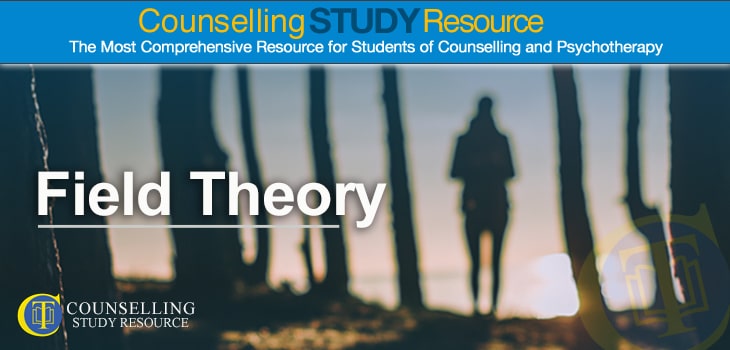Definition
Field theory investigates interaction patterns between individual people and the ‘field’, i.e., the environment. It is part of gestalt therapy, developed by Laura and Friedrich (‘Fritz’) Perls in the 1940s and 1950s. The Perls were influenced by Kurt Lewin, a gestalt psychologist in the 1940s; it was Lewin who introduced the concept of field theory.
Tudor and Merry (2006: 56) define ‘field theory’ as ‘the view, developed by Lewin (1952) and taken up particularly by gestalt therapy, that psychological relationships may – and indeed, can only – be studied and understood in terms of their surrounding “field”’. Sometimes known as ‘topological and vector psychology’, field theory was born in science (being ‘described elegantly by Einstein’s theory of relativity’: Yontef and Jacobs, 2005: 300).
Elements of Field Theory
Yontef and Jacobs (2005: 300) write: ‘Fields have certain properties that lead to a specific contextual theory. As with all contextual theories, a field is understood to be comprised of mutually interdependent elements’.
Lewin believed that behaviour (B) was a function (f) of the current ‘life space’ (LS) of a person. Lewin expressed this idea in the form of a mathematical equation: B = f(LS). Because life space is produced by the person (P) interacting with their environment (E), the formula can also be written as B = f(P,E).
The environment itself is an objective situation, but it is perceived subjectively by individual people, depending on their needs, beliefs, values and abilities. Both person-centred counselling and gestalt therapy are based on phenomenology. Perls, Hefferline and Goodman (1973: 19) wrote: ‘Only the interplay of organism and environment … constitutes the psychological situation, not the organism and environment taken separately’.
Personal development naturally affects – and may cause instability in – the life space. The same also holds true in reverse: instability in the life space can destabilise the individual.
How Field Theory Works
According to field theory, forces push a person towards their goal. While individuals may share a goal, the fields that they must pass through to achieve this goal are all different. Nor does each person’s field remain steady; instead, it is dynamic, constantly changing. Field changes can affect the person both in the present and in how that individual develops in future.
Implications for Practice
Yontef and Jacobs (2005: 300) observe: ‘A patient’s life story cannot tell you what actually happened in his or her past, but it can tell you how the patient experiences his or her history in the here and now. That rendition of history is shaped to some degree by the current field conditions.’ Thus, field theory in effect ‘renounces the belief that anyone, including a therapist, can have an objective perspective on reality’ (ibid.).
Tudor and Merry (56–57) note that ‘given Rogers’ definitions of awareness, and the belief of the PCA [person-centred approach] that people are essentially social animals … and its emphasis on group, it is perhaps surprising that field theory is not more figural in the theoretical ground of PCP [person-centred psychology]’.
Deutsch (1954: 478) writes: ‘It cannot be said that field theory as a specific psychological theory has much current vitality … His [Lewin’s] impact is reflected instead in his general orientation to psychology, which has left its impress on his colleagues and students’.
Free Handout Download
Field Theory
References
Deutsch M (1954) ‘Field Theory in Social Psychology’ in Lindzey G and Aronson E, The Handbook of Social Psychology, Vol. 1 (2nd ed.). pp. 412–487
Lewin (1952) Field Theory in Social Science, Harper & Rowe
Perls F, Hefferline RF and Goodman P (1973) Gestalt Therapy: Excitement and Growth in the Human Personality, Penguin
Tudor K and Merry T (2006) Dictionary of Person-Centred Psychology, PCCS Books
Yontef G and Jacobs L (2005) ‘Gestalt Therapy’ in Corsini R and Wedding D, Current Psychotherapies, Thomson Brookes/Cole
